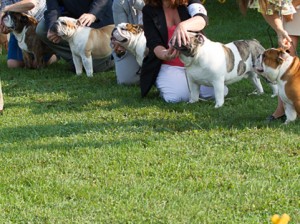Producing Pedigrees, Not Winners
By Amy Fernandez
 The nineteenth century author and judge, James Watson, was one of the dog world’s sharpest critics. He had plenty to say about every aspect of the game, but pedigree junkie ranked among his favorite targets. He thought it ironic that American breeders “worship the fetish of pedigree in animals – while holding that a man must be gauged by his individual merits.”
The nineteenth century author and judge, James Watson, was one of the dog world’s sharpest critics. He had plenty to say about every aspect of the game, but pedigree junkie ranked among his favorite targets. He thought it ironic that American breeders “worship the fetish of pedigree in animals – while holding that a man must be gauged by his individual merits.”
He constantly cautioned breeders and buyers not to rely on pedigrees as guarantees of quality, “Pedigree has its value but you must know something regarding the dogs in the pedigree either personally or from reliable information especially the history of the most prominent of the past generation or two to draw proper conclusions.”
Pedigrees don’t tell the whole story, but they usually offer us some reliable insights.
Few breeders can imagine making an important decision without them. It’s an indispensable tool, but Watson watched far too many people making uninformed decisions solely on this basis. “For most buyers the pedigree might as well be filled with random names, if enough of them happen to be preceded by Ch. They purchase two puppies like this – not related – and start breeding dogs to win prizes…such a breeder produces pedigrees, not winners.”
Watson was frustrated by this narrow-minded approach to dog evaluation, but that wasn’t his only reservation about certified pedigrees. Writing in 1907, he knew first hand what kinds of records often supported this official looking, certified documents.
Breeds existed long before the Kennel Club was founded in 1873. However, documented, purebred ancestry had never been the sole defining factor for that designation. The recognizable, consistent types that qualified as breeds were primarily a regional phenomena. Large, private breeding programs cultivated distinctive strains over the course of many human and canine generations. Just as often, breeds emerged locally, thanks to a combination of relative geographic isolation and consistent selection for a specific job. In either case, the value of any purebred type was situational.
Dog breeding was sort of like making chili. The basic recipe has many versions, and improvisation was expected. Breeders didn’t hesitate to incorporate new ingredients to improve their stock. It was a creative endeavor and the success of the final product was a matter of taste.
That started to change in 1874 when the Kennel Club began creating the first database of purebred lineage. They began by documenting the ancestry of dogs that had already been exhibited. This required backtracking fourteen years since dog shows started in 1859. Writing to more than 3,500 breeders and owners ultimately yielded a hodgepodge of names, dates, and pedigree details based on personal records, faded memories, and secondhand accounts. Assembling this collection into 4027 dog records for 40 different breeds qualifies as remarkable exercise in perseverance and determination, However, Watson emphasized that skepticism was warranted.
“Pedigrees have been traced farther back in Bedlingtons than in any other breed of terrier.” For example, he notes that many pedigrees traced back to the foundation sire Old Flint, whelped in 1782, “There are no end to broken lines in such a pedigree, besides which, we know absolutely nothing as to what Old Flint looked like….simply to suppose that he was a Bedlington such as we have today is because Bedlingtons can be traced back to him is absurd.” Watson made a good point, but Bedlingtons weren’t unique in that respect.
Along with recordkeeping inconsistencies, breeds were a work in progress. Very often, classification was based on physical appearance rather than ancestry. For instance, the Kennel Club lumped Dandies and Skyes together as Scottish Terriers until 1879. Needless to say, an entirely different breed usurped that name. Scotties, Westies and Cairns began as different strains of the same Highland stock. Littermates were often designated as one or the other. Eventually, white Scotties became Westies, short-haired Skyes became Cairns, etc. But pedigrees of short-legged Terrier breeds often contained the same ancestors.
Timing and circumstance also played a role. Dogs that were considered undesirable specimens of one breed because of their coat, color or size frequently found a niche as another emerging breed. When the Kennel Club finally recognized Irish Wolfhounds, quite a few Deerhounds changed their allegiance. “At the time when there were classes for Old English and also for Welsh terriers, one dog was shown in both classes at Darlington and won first in each!” Watson saw the humor in these amazing transformations, as well as their potential impact on breeding programs.
His advice may be more than century old, but it’s not outdated. Then as now, “individual excellence must take precedence over pedigree.”
Short URL: https://caninechronicle.com/?p=264472
Comments are closed












